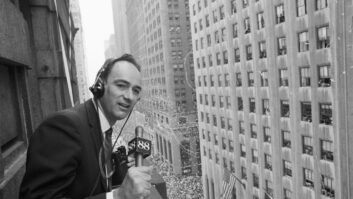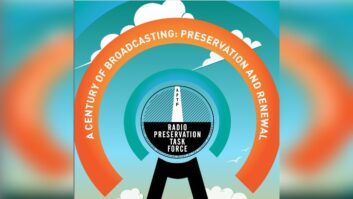I was honored to be asked to write the preface to the latest edition of the textbook “The Radio Station: Broadcasting, Streaming & Podcasting,” authored by John Allen Hendricks and Bruce Mims. The book is now in print from Routledge (find it at routledge.com, Amazon or other retail outlets).

In sitting down to write a few months back, I found it a thoughtful exercise to ask, “What would I want to tell someone who is thinking of taking up this field as a career?” Here’s the result, which I share with permission.
Welcome to the world of radio.
This book will open your awareness to the practices of a medium that enjoys unique power and romance. It will help you understand its career opportunities and how to pursue them.
But why, a century after revolutionizing mass communication, does radio remain so compelling? How has it thrived and reinvented itself while so many other media and electronic innovations have launched and disappeared?
Perhaps it’s the unique intimacy of a voice whispering in our ear.
Perhaps it’s the skill of a curator who helps us discover songs we didn’t know existed, of musicians who create soundtracks for our lives, of storytellers who create theater in our mind, of advertising professionals whose creative endeavors whet our appetite for their new products.
Maybe, too, it’s the thrill of pleasure at the sound of the crack of a baseball bat. Or it’s the “drop what we’re doing” urgency of hearing a meteorologist interrupt our afternoon music to tell us about a dangerous funnel cloud forming outside of town. Or the deep satisfaction of listening to a long-form interview with our favorite author, actor or digital innovator.
These are experiences from the listener’s perspective. Radio is best when it engages, provokes, entertains, informs us.
But who would not want to be the one creating those experiences?
The people who make good radio enjoy a special privilege, participating in the magic of creating intimate spaces in a very public way. I hope you’ll have the opportunity to feel this yourself; and you don’t have to be an air talent to do it. There are many crucial roles in creating this magic.
In their revised, expanded edition of “The Radio Station,” Bruce Mims and John Allen Hendricks have put extra emphasis on career opportunities — in music, news, sports, sales, engineering, IT, social media.
There are other new elements. The chapter on research includes an article from Andrew Forsyth at NielsenBDS about how to use data to identify and schedule new music, as well as an extended interview with Geoff Steadman of the Telos Alliance about its Voltair product and a discussion about changes in the influential Nielsen PPM ratings system. Cumulus Media’s Mike McVay and Producer Ray Slater of “The Bobby Bones Show” provide expert insights. Veteran communications attorney David Oxenford shares expertise about regulatory issues, music and copyright law.
This book is weighted toward commercial broadcasting operations in the United States, but will help you understand other forms including public, college, low-power FM and U.S. government-sponsored international broadcasting. Keep in mind too that other countries have their own regulatory regimes and transmission infrastructures that differentiate broadcasting further.
REINVENTION
If you are considering a radio career, I’d be doing you a disservice not to acknowledge that some people, particularly in U.S. commercial broadcasting, lament trends such as corporate consolidation, programming similarity, voicetracking and shrinking workforces. Critics also note the under-representation of women and minorities at ownership and management levels. Such factors undermine radio’s quality or competitiveness, in their view. I don’t dismiss these considerations, and if you enter the industry you will find debate over such issues to be a part of daily life.
But challenge anyone who tells you radio is a buggywhip industry. We live in an exciting time to enter media careers. Not only are thousands of people making careers in radio — many doing exceptional work — but the smartest of them work for companies eager to employ and develop forward-looking multimedia professionals.
Keep in mind too that those companies are also reinventing themselves; and the term “radio” can mean something much different than it did a few years ago. People debate what exactly the word means anymore. Does it still refer strictly to over-the-air, “one to many” programs broadcast via terrestrial towers and antennas to a multitude of receivers in local listenership communities? Does it include satellite radio? How about streamed audio and online services that combine access to traditional stations with personalized or curated content?
Are we listening to radio when we plug a smartphone into a car dashboard? Is the video stream of a station’s morning show part of “radio”? Why are podcasts considered different from radio? And what will come of emerging “hybrid” technologies that aim to bring an interactive, two-way aspect to our radio listening?
Radio is in a period of dramatic and accelerated evolution, as are the devices that carry our programs, as well as the very vehicles and living rooms where we want our “station” to be heard. Further, as consulting firm Research Director Inc. puts it, what was once a blind conversation is now a multidimensional relationship.
So ignore questions of definition. The listener doesn’t care if words and music arrive via a land-based tower, satellite or smart speaker. They want compelling content and experiences. Instead of asking “what is radio” or “what is a radio station,” the question broadcasters must ask ourselves is, “What business am I in?” You the reader have the opportunity in your career to define the answer. To me, ultimately, radio is about creating connections between us and a listener. Everything else is a tool to that end.
Radio though is unusually persistent. One learns to trust in this persistence. There’s something about the inherent connection between speaker and listener, something preserved in the electronic path between microphone to eardrum, that sets radio apart. Radio succeeds because it rests on one of the earliest of our developmental experiences: sharing human emotion through sounds.
When we create meaning in the mind of fellow humans, we engage in a far older form of communication than books or moving images. It’s noble. It’s fundamental. And it’s pretty dang cool.
Comment on this or any story. Note our new email address: [email protected].












